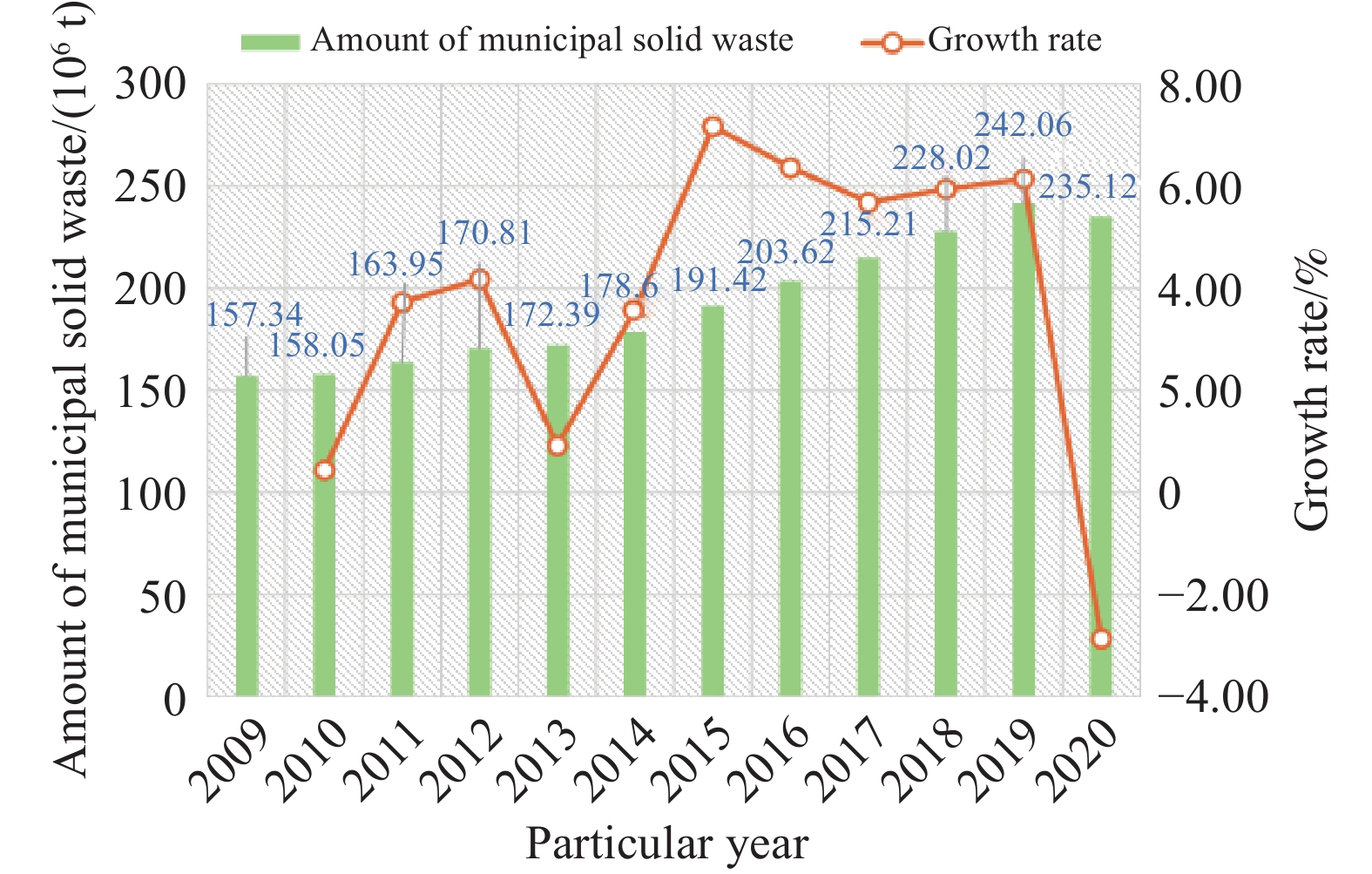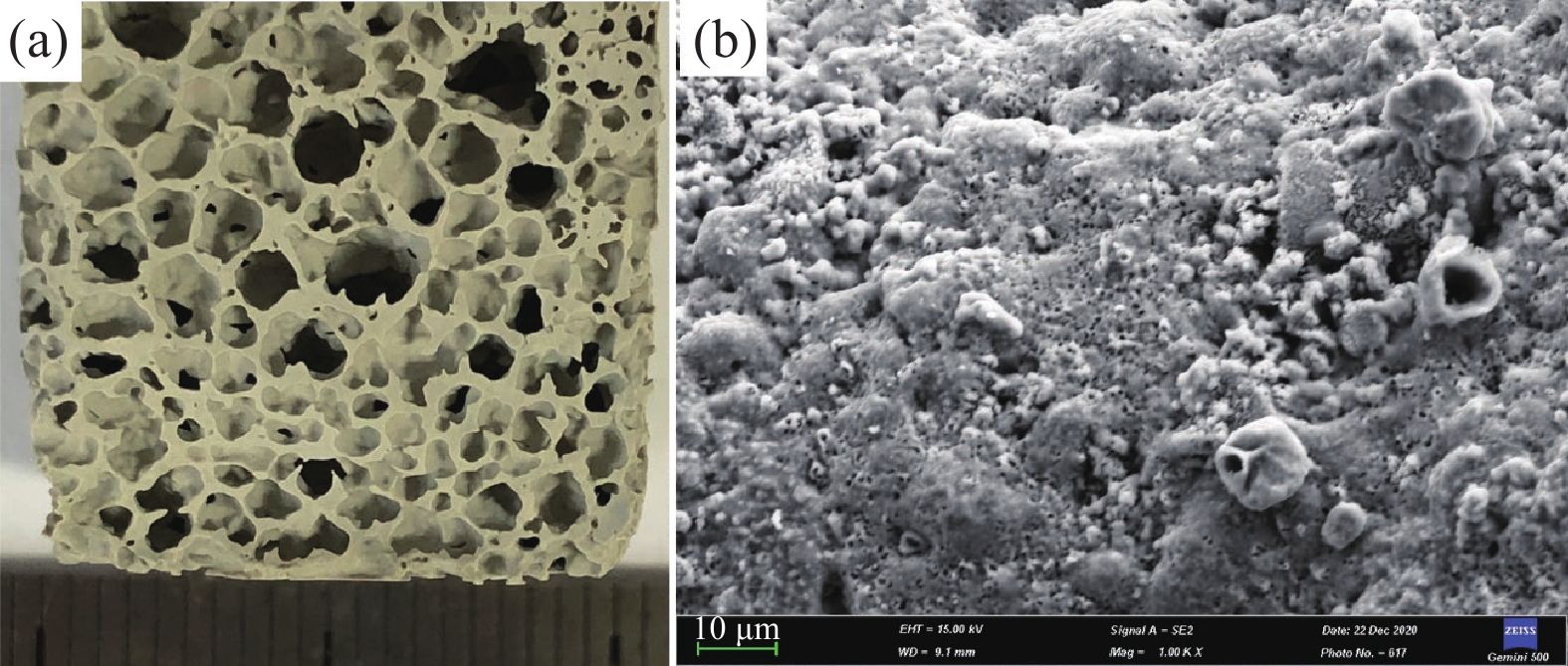Current state of the harmless melting and recycling of municipal solid waste incinerator fly ash
-
摘要: 垃圾焚燒飛灰因含二噁英和重金屬被列為危險廢物(HW18),存在環境污染風險,2020年全國生活垃圾焚燒量高達14607.6萬噸,以焚燒量5%(質量分數)計算,全國垃圾焚燒飛灰的產生量為730.4萬噸。目前垃圾焚燒飛灰以固化填埋為主,占用土地資源,且堆存量與處理量嚴重失衡,無法實現資源化,因此垃圾焚燒飛灰的無害化及資源化已成為綠色發展的瓶頸課題。本文詳細介紹了垃圾焚燒飛灰經熔融無害化及資源化的研究現狀,闡述了熔融處理垃圾焚燒飛灰的重金屬固化、二噁英降解機理,結合熔融形成的玻璃渣分析了制備微晶玻璃、泡沫微晶玻璃、膠凝材料的資源化技術,并指出現有玻璃化雖能固化重金屬,但在后續資源化以及產品服役過程,重金屬的遷移規律、浸出性需要進一步研究,為垃圾焚燒飛灰的綜合利用提供了參考。Abstract: In 2020, the municipal solid waste removal and transportation volume reached 235.117 million tons, of which 146.076 million tons were incinerated in China. Because it can reduce the harmfulness of waste and recycle energy, municipal solid waste incineration (MSWI) technology has become the primary method for the disposal treatment of urban domestic waste in China. However, this method produces MSWI fly ash, which is defined as a hazardous waste rich in dioxins and heavy metals. Calculated based on 5% (mass fraction) of the original waste, the output of MSWI fly ash in China nearly reached 7.304 million tons in 2020. Moreover, the stockpile management and treatment capacities are seriously out of balance. At present, the main disposal method of MSWI fly ash is landfilling, which consumes land resources and poses an environmental hazard. As a result, the harmlessness and recyclability of MSWI fly ash have become a bottleneck for green development. In this review, the harmless melting and recycling of MSWI fly ash are introduced in detail. The mechanisms of heavy metal solidification and dioxin degradation during MSWI fly ash melting have been explained. MSWI fly ash can be transformed into glass slag containing CaO?SiO2?Al2O3 after co-melting with other solid wastes rich in silicon aluminum oxide. Heavy metals in MSWI fly ash can be solidified at the atomic scale in the silicate network of glass. More importantly, as the temperature increases beyond 800 °C, dioxins undergo dechlorination and degradation, reducing the harmfulness and revealing the harmlessness of MSWI fly ash. This review also describes how to deal with the glass slag that forms because of co-melting. The glass slag has low added value and poor mechanical properties. Future disposal trends for vitrified slag from MSWI fly ash, including glass–ceramic, glass–ceramic foam, and cementitious materials, have been proposed. Given that vitrification can solidify heavy metals in the process of subsequent resource usage and product service, the migration and leaching characteristics of heavy metals need to be further investigated. This study provides a reference for the comprehensive usage of MSWI fly ash.
-
Key words:
- MSWI fly ash /
- melting /
- vitrification /
- glass ceramic foams /
- heavy metals
-
久色视频
表 1 飛灰重金屬質量濃度及浸出毒性[14]
Table 1. Concentration and leaching toxicity of heavy metals in MSWI fly ash[14]
Heavy metal elements Concentration/
(mg·L?1)Standard for leaching toxicity of MSWI
in China/
(mg·L?1)Criteria for landfills for nonhazardous waste in Europe/
(mg·L?1)Zn 3269.0 100.00 50.00 Pb 1515.0 0.25 10.0 Cu 563.2 40.00 50.0 Cd 36.7 0.15 1.0 Cr 157.0 4.50 10.0 Hg 35.8 0.05 0.2 -
參考文獻
[1] National Bureau of statistics of the people's Republic of China. China Statistical Yearbook 2021. Beijing: China Statistics Press, 2021中華人民共和國國家統計局. 中國統計年鑒2021. 北京: 中國統計出版社, 2021 [2] Wu H, Liu H B, Tian S L, et al. Current situation for utilization and disposal and environmental management of fly ash from municipal solid waste incineration. J Environ Eng Technol, 2021(5): 1034 doi: 10.12153/j.issn.1674-991X.20210083吳昊, 劉宏博, 田書磊, 等. 城市生活垃圾焚燒飛灰利用處置現狀及環境管理. 環境工程技術學報, 2021(5):1034 doi: 10.12153/j.issn.1674-991X.20210083 [3] Ma W C, Shi W B, Shi Y J, et al. Plasma vitrification and heavy metals solidification of MSW and sewage sludge incineration fly ash. J Hazard Mater, 2021, 408: 124809 doi: 10.1016/j.jhazmat.2020.124809 [4] Jiang X G, Chen Q, Zhao X L, et al. A review on hydrothermal treatment for stabilization of heavy metals in fly ash from municipal solid waste incineration. Chem Ind Eng Prog, 2021, 40(8): 4473蔣旭光, 陳錢, 趙曉利, 等. 水熱法穩定垃圾焚燒飛灰中重金屬研究進展. 化工進展, 2021, 40(8):4473 [5] Kang D, Son J, Yoo Y, et al. Heavy-metal reduction and solidification in municipal solid waste incineration (MSWI) fly ash using water, NaOH, KOH, and NH4OH in combination with CO2 uptake procedure. Chem Eng J, 2020, 380: 122534 doi: 10.1016/j.cej.2019.122534 [6] Li W H, Ma Z Y, Huang Q X, et al. Distribution and leaching characteristics of heavy metals in a hazardous waste incinerator. Fuel, 2018, 233: 427 doi: 10.1016/j.fuel.2018.06.041 [7] Zhou J Z, Wu S M, Pan Y, et al. Enrichment of heavy metals in fine particles of municipal solid waste incinerator (MSWI) fly ash and associated health risk. Waste Manag, 2015, 43: 239 doi: 10.1016/j.wasman.2015.06.026 [8] Bernasconi D, Caviglia C, Destefanis E, et al. Influence of speciation distribution and particle size on heavy metal leaching from MSWI fly ash. Waste Manag, 2022, 138: 318 doi: 10.1016/j.wasman.2021.12.008 [9] Cai P T, Fu J Y, Zhan M X, et al. Formation mechanism and influencing factors of dioxins during incineration of mineralized refuse. J Clean Prod, 2022, 342: 130762 doi: 10.1016/j.jclepro.2022.130762 [10] Mao L Q, Guo H J, Zhang W Y. Addition of waste glass for improving the immobilization of heavy metals during the use of electroplating sludge in the production of clay bricks. Constr Build Mater, 2018, 163: 875 doi: 10.1016/j.conbuildmat.2017.12.177 [11] Zhang J J, Liu B, Zhang S G. A review of glass ceramic foams prepared from solid wastes: Processing, heavy-metal solidification and volatilization, applications. Sci Total Environ, 2021, 781: 146727 doi: 10.1016/j.scitotenv.2021.146727 [12] Gao J, Dong C Q, Zhao Y, et al. Vitrification of municipal solid waste incineration fly ash with B2O3 as a fluxing agent. Waste Manag, 2020, 102: 932 doi: 10.1016/j.wasman.2019.12.012 [13] Morsi R M M, Basha M A F, Morsi M M. Synthesis and physical characterization of amorphous silicates in the system SiO2-Na2O-RO (R = Zn, Pb or Cd). J Non Cryst Solids, 2016, 439: 57 doi: 10.1016/j.jnoncrysol.2016.02.018 [14] Huang B B, Gan M, Ji Z Y, et al. Recent progress on the thermal treatment and resource utilization technologies of municipal waste incineration fly ash: A review. Process Saf Environ Prot, 2022, 159: 547 doi: 10.1016/j.psep.2022.01.018 [15] Zhang J J, Zhang S G, Liu B. Degradation technologies and mechanisms of dioxins in municipal solid waste incineration fly ash: A review. J Clean Prod, 2020, 250: 119507 doi: 10.1016/j.jclepro.2019.119507 [16] Lin X Q, Chen Z L, Lu S Y, et al. Emission characteristics of polychlorinated dibenzo-p-dioxins and dibenzofurans from the co-combustion of municipal solid waste in a lab-scale drop-tube furnace. Energy Fuels, 2018, 32(4): 5396 doi: 10.1021/acs.energyfuels.8b00408 [17] Ji Z Y, Huang B B, Gan M, et al. Dioxins control as co-processing water-washed municipal solid waste incineration fly ash in iron ore sintering process. J Hazard Mater, 2022, 423: 127138 doi: 10.1016/j.jhazmat.2021.127138 [18] Katou K, Asou T, Kurauchi Y, et al. Melting municipal solid waste incineration residue by plasma melting furnace with a graphite electrode. Thin Solid Films, 2001, 386(2): 183 doi: 10.1016/S0040-6090(00)01640-0 [19] Zhang S, Chen Z L, Lin X Q, et al. Kinetics and fusion characteristics of municipal solid waste incineration fly ash during thermal treatment. Fuel, 2020, 279: 118410 doi: 10.1016/j.fuel.2020.118410 [20] Wong G, Gan M, Fan X H, et al. Co-disposal of municipal solid waste incineration fly ash and bottom slag: A novel method of low temperature melting treatment. J Hazard Mater, 2021, 408: 124438 doi: 10.1016/j.jhazmat.2020.124438 [21] Chen Z L, Lin X Q, Zhang S, et al. Thermal cotreatment of municipal solid waste incineration fly ash with sewage sludge for PCDD/Fs decomposition and reformation suppression. J Hazard Mater, 2021, 416: 126216 doi: 10.1016/j.jhazmat.2021.126216 [22] Lin X Q, Mao T Y, Chen Z L, et al. Thermal cotreatment of municipal solid waste incineration fly ash with sewage sludge: Phases transformation, kinetics and fusion characteristics, and heavy metals solidification. J Clean Prod, 2021, 317: 128429 doi: 10.1016/j.jclepro.2021.128429 [23] Kim K, Kim K, Kim M. Characterization of municipal solid-waste incinerator fly ash, vitrified using only end-waste glass. J Clean Prod, 2021, 318: 128557 doi: 10.1016/j.jclepro.2021.128557 [24] Kim M, Kim H G, Kim S, et al. Leaching behaviors and mechanisms of vitrified forms for the low-level radioactive solid wastes. J Hazard Mater, 2020, 384: 121296 doi: 10.1016/j.jhazmat.2019.121296 [25] Yang J, Liu B, Zhang S G, et al. Glass-ceramics one-step crystallization accomplished by building Ca2+ and Mg2+ fast diffusion layer around diopside crystal. J Alloys Compd, 2016, 688: 709 doi: 10.1016/j.jallcom.2016.07.027 [26] Fan W D, Liu B, Luo X, et al. Production of glass–ceramics using Municipal solid waste incineration fly ash. Rare Met, 2019, 38(3): 245 doi: 10.1007/s12598-017-0976-8 [27] Fan W D. Manufacture of Glass-Ceramic Made from Municipal Solid Waste Incineration Fly Ash and the Solidification Mechanism of Cr [Dissertation]. Beijing: University of Science and Technology Beijing, 2018范文迪. 垃圾焚燒飛灰微晶玻璃化及Cr固化機理[學位論文]. 北京: 北京科技大學, 2018 [28] Zhao S Z, Liu B, Ding Y J, et al. Study on glass-ceramics made from MSWI fly ash, pickling sludge and waste glass by one-step process. J Clean Prod, 2020, 271: 122674 doi: 10.1016/j.jclepro.2020.122674 [29] Zhao S Z, Zhang X Y, Liu B, et al. Preparation of glass-ceramics from high-chlorine MSWI fly ash by one-step process. Rare Met, 2021, 40(11): 3316 doi: 10.1007/s12598-021-01770-9 [30] Vu D H, Wang K S, Chen J H, et al. Glass-ceramic from mixtures of bottom ash and fly ash. Waste Manag, 2012, 32(12): 2306 doi: 10.1016/j.wasman.2012.05.040 [31] Li B Q, Guo Y P, Fang H S, et al. Effect of crystallization temperature on crystallization and properties of CaO-Al2O3-MgO-SiO2 glass-ceramics from fly ash and waste panel glass. J Ceram, 2018, 39(4): 443李保慶, 郭艷平, 方紅生, 等. 晶化溫度對飛灰/廢屏玻璃協同制備CaO-Al2O3-MgO-SiO2系微晶玻璃析晶及性能的影響. 陶瓷學報, 2018, 39(4):443 [32] Li B Q, Guo Y P, Dang H F. Effect of MgO on crystallization and properties of glass ceramics from fly ash and waste glass. Multipurp Util Miner Resour, 2020(1): 135 doi: 10.3969/j.issn.1000-6532.2020.01.028李保慶, 郭艷平, 黨海峰. MgO對飛灰屏玻璃協同制備微晶玻璃析晶及性能的影響. 礦產綜合利用, 2020(1):135 doi: 10.3969/j.issn.1000-6532.2020.01.028 [33] Elsayed H, Romero A R, Picicco M, et al. Glass-ceramic foams and reticulated scaffolds by sinter-crystallization of a hardystonite glass. J Non Cryst Solids, 2020, 528: 119744 doi: 10.1016/j.jnoncrysol.2019.119744 [34] Zhang J J, Zhang X Y, Liu B, et al. Phase evolution and properties of glass ceramic foams prepared by bottom ash, fly ash and pickling sludge. Int J Miner Metall Mater, 2022, 29(3): 563 doi: 10.1007/s12613-020-2219-5 [35] Sasmal N, Garai M, Karmakar B. Preparation and characterization of novel foamed porous glass-ceramics. Mater Charact, 2015, 103: 90 doi: 10.1016/j.matchar.2015.03.007 [36] Tarrago M, Garcia-Valles M, Aly M H, et al. Valorization of sludge from a wastewater treatment plant by glass-ceramic production. Ceram Int, 2017, 43(1): 930 doi: 10.1016/j.ceramint.2016.10.083 [37] Liu T Y, Liu P, Guo X G, et al. Preparation, characterization and discussion of glass ceramic foam material: Analysis of glass phase, fractal dimension and self-foaming mechanism. Mater Chem Phys, 2020, 243: 122614 doi: 10.1016/j.matchemphys.2019.122614 [38] Si R Z, Dai Q L, Guo S C, et al. Mechanical property, nanopore structure and drying shrinkage of metakaolin-based geopolymer with waste glass powder. J Clean Prod, 2020, 242: 118502 doi: 10.1016/j.jclepro.2019.118502 [39] Liu B, Yang Q W, Zhang S G. Integrated utilization of municipal solid waste incineration fly ash and bottom ash for preparation of foam glass–ceramics. Rare Met, 2019, 38(10): 914 doi: 10.1007/s12598-019-01314-2 [40] da Silva R C, Kubaski E T, Tenório-Neto E T, et al. Foam glass using sodium hydroxide as foaming agent: Study on the reaction mechanism in soda-lime glass matrix. J Non Cryst Solids, 2019, 511: 177 doi: 10.1016/j.jnoncrysol.2019.02.003 [41] Han J S, Li G H, Gao H N, et al. Foaming mechanisms of different foaming agents and their effects on the microstructures of porous magnesia ceramics. J Aust Ceram Soc, 2020, 56(3): 1005 doi: 10.1007/s41779-019-00443-2 [42] Li J, Zhuang X G, Monfort E, et al. Utilization of coal fly ash from a Chinese power plant for manufacturing highly insulating foam glass: Implications of physical, mechanical properties and environmental features. Constr Build Mater, 2018, 175: 64 doi: 10.1016/j.conbuildmat.2018.04.158 [43] Fernandes H R, Andreola F, Barbieri L, et al. The use of egg shells to produce Cathode Ray Tube (CRT) glass foams. Ceram Int, 2013, 39(8): 9071 doi: 10.1016/j.ceramint.2013.05.002 [44] Petersen R R, K?nig J, Yue Y Z. The viscosity window of the silicate glass foam production. J Non Cryst Solids, 2017, 456: 49 doi: 10.1016/j.jnoncrysol.2016.10.041 [45] Rincón A, Giacomello G, Pasetto M, et al. Novel ‘inorganic gel casting’ process for the manufacturing of glass foams. J Eur Ceram Soc, 2017, 37(5): 2227 doi: 10.1016/j.jeurceramsoc.2017.01.012 [46] Rincón A, Desideri D, Bernardo E. Functional glass-ceramic foams from ‘inorganic gel casting’ and sintering of glass/slag mixtures. J Clean Prod, 2018, 187: 250 doi: 10.1016/j.jclepro.2018.03.065 [47] Zhang J J, Liu B, Zhang X Y, et al. A novel approach for preparing glass ceramic foams from MSWI fly ash: Foaming characteristics and hierarchical pore formation mechanism. J Mater Res Technol, 2022, 18: 731 doi: 10.1016/j.jmrt.2022.02.090 [48] Zhang J J. Preparation and Mechanism of Glass-Ceramic Foams Based on Municipal Solid Waste Incineration Ash [Dissertation]. Beijing: University of Science and Technology Beijing, 2021張俊杰. 垃圾焚燒灰渣制備泡沫微晶玻璃工藝及其機理[學位論文]. 北京: 北京科技大學, 2021 [49] Lin K L, Wang K S, Tzeng B Y, et al. The hydration characteristics and utilization of slag obtained by the vitrification of MSWI fly ash. Waste Manag, 2004, 24(2): 199 doi: 10.1016/S0956-053X(03)00131-4 [50] Lee T C, Wang W J, Shih P Y. Slag-cement mortar made with cement and slag vitrified from MSWI fly-ash/scrubber-ash and glass frit. Constr Build Mater, 2008, 22(9): 1914 doi: 10.1016/j.conbuildmat.2007.07.030 -





 下載:
下載:


